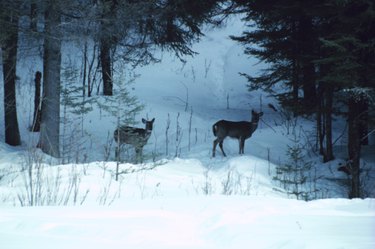
Arborvitae is a common shrub that is hardy to USDA plant hardiness zones 3 through 7. It has dense growth and makes a natural screen when several are planted close together. They are evergreen shrubs with varieties including short, globular arborvitae and tall, pyramidal shrubs. Many gardeners praise the plant for its hardiness and growth rate -- techny arborvitae grows up to 4 feet per year -- but there are a few drawbacks to consider before planting arborvitae.
Overused
Video of the Day
Eastern or American arborvitae is perhaps the most common arborvitae in the U.S., and grows up to 50 feet tall. Four other species, including one more native to North America and three native to Asia, plus countless cultivars varying in size and shape are also available. Regardless of the size of the species or cultivar, different arborvitae share the same general appearance -- a look that many believe is repeated too often in American landscapes. They are fairly easy to grow given moist, well-drained soil and full sun, which may explain their popularity. Another explanation may be their versatility; they are used to conceal foundations, as accent plants, and for hedges and screen. These uses make them a quick first choice for contractors who want to complete a house with a simple landscape.
Video of the Day
Drought
While it's true that arborvitae is easy to grow under the right conditions, it can be a hassle if it doesn't receive enough water. Leaves dry out, turn brown and eventually fall off the plant. The shrub may have a permanent gap in its foliage if it loses leaves to drought. You can prevent this unsightly occurrence by monitoring arborvitae during the dry season. When you don't receive regular rain, give the ground around arborvitae a thorough soaking to a depth of about 2 feet once every two weeks or as needed. You can help the roots to retain moisture by mulching around the plants. Mulching and soaking the ground prior to freezing can also protect arborvitae from drying as a result of high winds.
Loses Shape
Numerous conditions, including age and weather, may cause arborvitae shrubs to lose their shape. As they age, older arborvitae branches may simply break off. In other cases, high wind and heavy snow can break branches. In either case, the plant is left with gaps where it formerly had dense growth. The shape may be improved by pruning, but the gaps are often eyesores that must simply be replaced. You might also receive heavy snow that weighs down a few branches without actually breaking them. If snow is not shaken off branches, they can bend severely and never straighten back to their original state.
Pests
Arborvitae doesn't have to compete with many pests, but the ones that affect these plants can be serious problems. Leafminers lay larvae between leaf scales, which then feed on the needles from the tips of the plants. The damage may go unnoticed until the following winter or spring when brown tips are observable. Light infestation can be helped by pruning browning tips; heavier infestation may require introducing parasites to eat larvae and pupae. Bagworms also take up residence on arborvitae leaves and the caterpillar form causes the most damage to leaves. They can be removed by hand in late fall or winter. Deer are much larger pests that can wreak serious havoc on arborvitae shrubs. When the winter food supply is low, deer are known to browse arborvitae shrubs, which they consider a tasty snack. Homeowners may be able deter deer by hanging bar soap near arborvitae.
Diseases
Gardeners may experience problems from several types of fungal diseases. Pestalotiopsis is indicated by dead spots, blotches and cankers. Needle blight causes yellowing and browning on leaves. Shoot blight affects new growth through wilting and browning; plants under stress from freezing temperatures or with moist, colonized plant tissue are especially at risk. Botrytis blight, a result of low light and temperature and lack of nutrition, reveals itself as fuzzy, gray mold. Oriental arborvitae commonly suffer from Cercospora leaf blight, symptoms of which include leaf browning and leaf loss. Phomopsis blight is common in American and Oriental arborvitae; symptoms are yellow spots, fading of shoots, reddish brown shoots, cankers and a gray band at the point of infection. Kabatina and Sclerophoma blights cause gray lesions at the base of older blighted lesions.